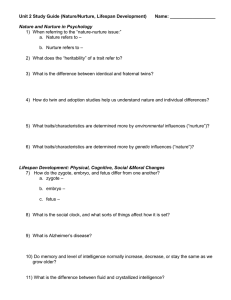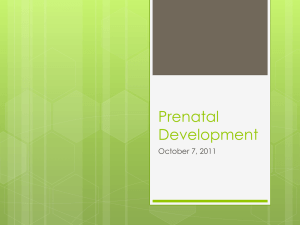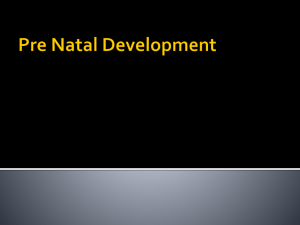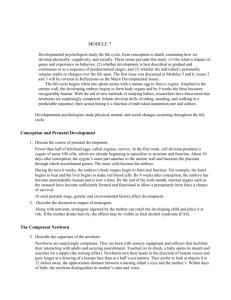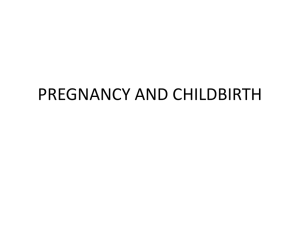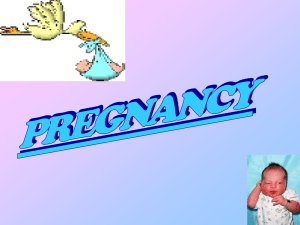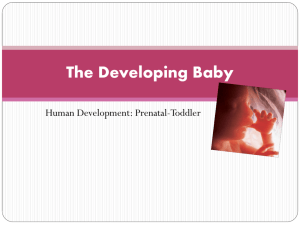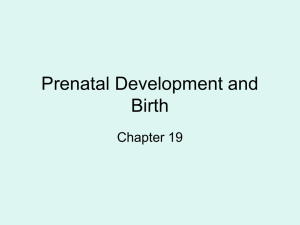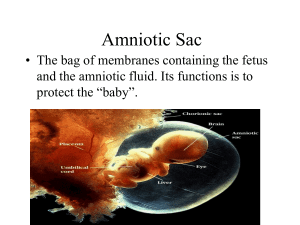File
advertisement
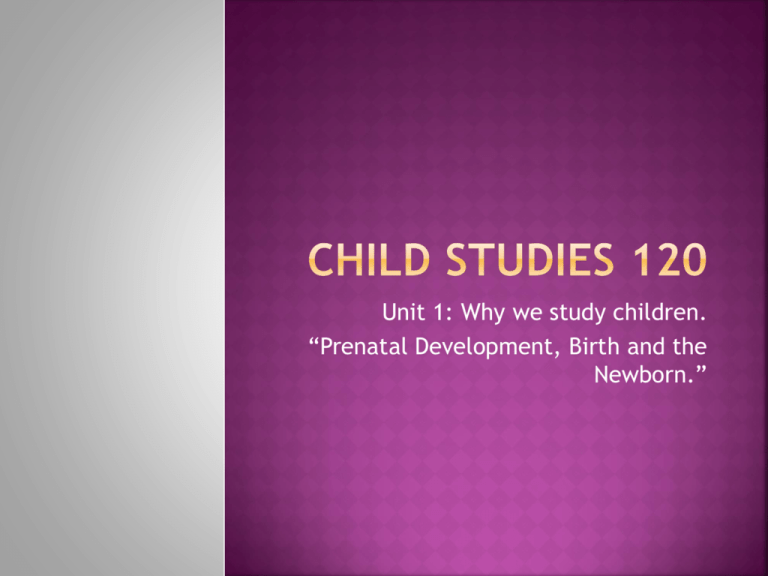
Unit 1: Why we study children. “Prenatal Development, Birth and the Newborn.” 1. 2. 3. 4. 5. You will better understand why children act, feel and think as they do. You will understand the importance of parents and caregivers. You will gain skills. You will understand yourself. It will help you to build for the future. Childhood is a time of preparation and scientists are finding that early childhood may be the most important stages of life for a person. The brain of a child develops important connections between nerve cells that allow it to think and control the body in certain ways, in the first few years of life. These connections do not just happen on their own. Children need to be encouraged and given lots of stimulation. The links that develop in the child’s brain promote mental and physical skills. They also will have an impact on the social and emotional characteristics of that child as an adult. Children benefit from play in many ways… 1. Physically: Running, jumping, climbing and riding a bike help develop the large muscles of the back, arms, and legs. Making puzzles, finger painting, and stringing beads all help a child to learn to control the small muscles of the hands. 2. Socially: Playing together. Skills such as taking turns and working together are learned. 3. Emotionally: Help children work through life’s challenges such as the frustrations of being a small person in a big world. 4. Morally: Play teaches valuable lessons about right and wrong. Play also helps children to follow rules and act fair towards others. 5. Intellectually: Toys do not have to be “educational” to promote mental development. Simple activities such as singing nursery rhymes, stacking blocs and sorting all promote intellectual development. “The study of how children master new skills.” What promotes growth and development? -Heredity: “The passing on of certain characteristics from earlier generations.” (Nature) -Environment: “The people, places and things that surround and influence a person.” (Nurture) -Healthy Body: Physically and mentally. -Nutrition: “The process of providing or obtaining the food necessary for health and growth.” Definition: The nature versus nurture debate is one of the oldest issues in psychology. The debate centers on the relative contributions of genetic inheritance and environmental factors to human development. Some philosophers such as Plato and Descartes suggested that certain things are inborn, or that they simply occur naturally regardless of environmental influences. Other well-known thinkers such as John Locke believed in what is known as tabula rasa, which suggests that the mind begins as a blank slate. According to this notion, everything that we are and all of our knowledge is determined by our experience. For example, when a person achieves tremendous academic success, did they do so because they are genetically predisposed to be successful or is it a result of an enriched environment? Today, the majority of experts believe that behavior and development are influenced by both nature and nurture. In groups of 4, discuss the issue of nature vs. nurture. What are your group’s opinions on this issue. Is development influenced by nature (heredity) or nurture (environment)? One group member must record opinions and another group member needs to be the speaker and present findings to class. http://www.youtube.com/watch?v=TJAB7OS 4fXg http://www.cbc.ca/natureofthings/episode/ born-to-be-good-1.html Nature vs. Nurture Project During pregnancy, a single cell grows and develops into a human, being capable of independent life. This process, which takes about nine months, is called prenatal development. Conception: About once each month, an ovum ( a female cell or egg) is released by one of a women’s ovaries. The egg moves through the fallopian tubes to the uterus. The uterus is the organ in a women’s body in which a baby develops during pregnancy. The journey takes about two to three days. The egg meets and is fertilized by a sperm, or male cell. When the ovum and a sperm unite, conception take place, and pregnancy beings. There are three to four days in each woman’s cycle during which intercourse could lead to conception. A baby’s development is often grouped into three stages; period of the zygote, the embryo, and the fetus. Period of the Zygote: Fertilized Egg. This period last about two weeks. -The zygote travels down the fallopian tubes and attaches itself to the thickened lining of the uterus. -This is where the zygote draws nourishment from the mother’s body. -The zygote is the size of a pinhead and grows by cell division. Period of the Embryo: Second stage. -Third through eight weeks of pregnancy. -The embryo grows rapidly. -Several important and amazing changes occur. -Mass of cells develops into all the major systems of the human body (Heart, lungs, bones and muscles). -Even this early the brain begins to take control of these body systems. -A sac filled with fluid forms around the embryo. This amniotic fluid protects the developing baby and acts as a cushion. -A tissue called the placenta develops. The placenta is rich in blood vessels. -The mother’s blood stream carries food and oxygen to the placenta through the umbilical cord. Period of the Fetus: Third and last stage of pregnancy. -Begins around the eighth or ninth week and lasts until birth. -Around four to five months, a mother can begin to feel the baby’s movements. -By the seventh month, a fetus is capable of living outside the uterus, but not without medical help. -The fetus can suck its, thumb, cough, sneeze, yawn, kick and hiccup. 1. 2. 3. 4. What cells join together to cause conception? What happens during the period of the zygote? How long does it last? What changes might a pregnant woman feel in the period of the zygote and embryo? What four changes take place in the period of the embryo? -Activity: With the use of the the internet, explain in your own words the development of a baby from month 1 to month 9. Include pictures of a baby at each month with your monthly description. This can be done in point form. Include at least 4 points for each month. -Size: About 14 -16 inches and about 4 pounds. -Weight gain continues rapidly. -May react to loud noises with a reflex jerking action. -Moves into a head down position. -Kidneys are developed. -Tremendous brain growth. Midwives: Health professionals who provide primary care to women and their babies during pregnancy, labor, birth, and the postpartum period. In some cases, they replace the role of the doctor or assist the doctor in the hospital, home, or birthing centers. Doula: An individual who assists a women in labor; a labor coach before, during and after childbirth. A doula helps a woman feel confident and safe. Prepared Childbirth- method of giving birth in which pain is reduced through the elimination of fear and the use of conditioning exercises. -A woman knows instinctively how to give birth -there are many helpful classes in preparing for this exciting day. -parents will learn what happens in labor and how to deal with the process. -Labor: the process by which the baby gradually moves out of the uterus and into the vagina to be born.
